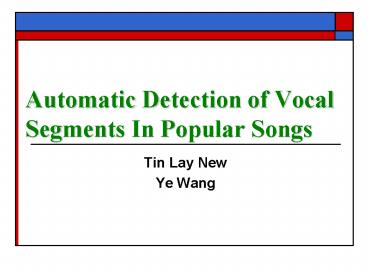Automatic Detection of Vocal Segments In Popular Songs PowerPoint PPT Presentation
1 / 17
Title: Automatic Detection of Vocal Segments In Popular Songs
1
Automatic Detection of Vocal Segments In Popular
Songs
- Tin Lay New
- Ye Wang
2
Introduction
- Voice signal tends to have a higher rate of
change than instrumental music - The straightforward method to detect vocals is to
note the energy within the frequencies bounded by
the range of vocal energy - Features that can measure the harmonic content of
the music signal are important for detecting
vocals in a song
3
Abstract
- Technique for the automatic classification of
vocal and non-vocal regions - Improve the conventional Hidden Markov Model
(HMM) for classification - Experimental evaluations conducted on a database
of 20 popular songs
4
Acoustic Features
- If vocals begin while instrumental is going on, a
sudden increase in the energy level of the audio
signal is observed - We extract feature parameters based on the
distribution of energy in different frequency
bands in the range from 130Hz to 16 kHz
5
Acoustic Features (cont.)
- First, the test song is blocked into 200ms
analysis frames - LFPC features are calculated from 20ms with 13ms
overlapping subframes - Each frame is multiplied with a Hamming window to
minimize signal discontinuities at the end of
each frame, then Fast Fourier Transform (FFT) is
computed
6
Log Frequency Power Coefficients (LFPC)
7
Log Frequency Power Coefficients (Cont.)
- LFPC parameters provide an indication of energy
distribution among subbands are calculated as
follows
8
Classifier Formulation
- Takes song structure information into account in
song modeling - For example, signal strengths in different
sections (intro, verse, chorus, bridge and outro)
are usually different - Tempo and loudness are important attributes
9
Classifier Formulation (Cont.)
10
About HMM
- Using Multi-model HMM (MM-HMM) classifier
- What is HMM?
- Hidden Markov Model??HMM
- ???????(Pattern Recognition)???,????Training
Data, ????Model,???????????,??Testing
Data,???????????????,?????????? - ???????????
- 1. ????(The Evaluation Problem)
- 2. ????(The Decoding Problem)
- 3. ????(The Learning Problem)
11
Classifier Formulation (Cont.)
- Annotated vocal and non-vocal segments of every
test song to train their model by human - Segment songs into vocal and non-vocal segments
using the MM-HMM classifier - Then use the segmentation as bootstrapped sample
to build song-specific vocal and non-vocal models
of the test song with a bootstrapping process
12
Experiments (About Frame Size)
13
Experiments (database)
14
Experiments (result)
15
Experiments (probability)
16
Improvement
- Enable a semi-automatic system--
- instead of choosing bootstrapping samples
randomly, we could allow the user to check and to
select the bootstrapped samples (vocal and
non-vocal segments) manually from the initial
segmentation performed by the MM-HMM
17
Conclusion
- In a test dataset comprising 14 popular songs,
our approach has achieved an accuracy of 84.3 in
identifying vocal segments from non-vocal ones - But theres still one drawback
- It is computationally expensive since it entails
two training steps training the MM-HMM
classifier and training the bootstrapped
classifier

